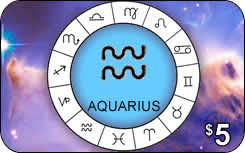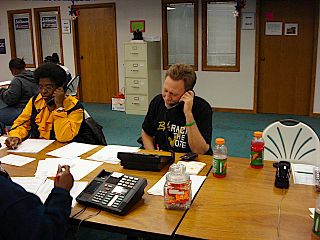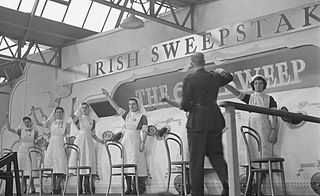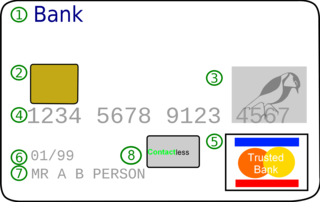Related Research Articles

In probability theory, the sample space of an experiment or random trial is the set of all possible outcomes or results of that experiment. A sample space is usually denoted using set notation, and the possible ordered outcomes, or sample points, are listed as elements in the set. It is common to refer to a sample space by the labels S, Ω, or U. The elements of a sample space may be numbers, words, letters, or symbols. They can also be finite, countably infinite, or uncountably infinite.

In probability theory, an event is a set of outcomes of an experiment to which a probability is assigned. A single outcome may be an element of many different events, and different events in an experiment are usually not equally likely, since they may include very different groups of outcomes. An event consisting of only a single outcome is called an elementary event or an atomic event; that is, it is a singleton set. An event is said to occur if contains the outcome of the experiment. The probability that an event occurs is the probability that contains the outcome of an experiment. An event defines a complementary event, namely the complementary set, and together these define a Bernoulli trial: did the event occur or not?

A telephone card, calling card or phonecard for short, is a credit card-size plastic or paper card, used to pay for telephone services. It is not necessary to have the physical card except with a stored-value system; knowledge of the access telephone number to dial and the PIN is sufficient. Standard cards which can be purchased and used without any sort of account facility give a fixed amount of credit and are discarded when used up; rechargeable cards can be topped up, or collect payment in arrears. The system for payment and the way in which the card is used to place a telephone call vary from card to card.

Telemarketing is a method of direct marketing in which a salesperson solicits prospective customers to buy products or services, either over the phone or through a subsequent face to face or web conferencing appointment scheduled during the call. Telemarketing can also include recorded sales pitches programmed to be played over the phone via automatic dialing.

A payphone is typically a coin-operated public telephone, often located in a telephone booth or in high-traffic outdoor areas, with prepayment by inserting money or by billing a credit or debit card, or a telephone card. Prepaid calling cards also facilitate establishing a call by first calling the provided toll-free telephone number, entering the card account number and PIN, then the desired telephone number. An equipment usage fee may be charged as additional units, minutes or tariff fee to the collect/third-party, debit, credit, telephone or prepaid calling card when used at payphones. By agreement with the landlord, either the phone company pays rent for the location and keeps the revenue, or the landlord pays rent for the phone and shares the revenue.
Marketing research is the systematic gathering, recording, and analysis of qualitative and quantitative data about issues relating to marketing products and services. The goal is to identify and assess how changing elements of the marketing mix impacts customer behavior.

In the United States, bingo is a game of chance in which each player matches the numbers printed in different arrangements on cards. The game host (caller) draws at random, marking the selected numbers with tiles. When a player finds the selected numbers are arranged on their card in a row, they call out "Bingo!" to alert all participants to a winning card, which prompts the game host to examine the card for verification of the win. Players compete against one another to be the first to have a winning arrangement for the prize or jackpot. After a winner is declared, the players clear their number cards of the tiles and the game host begins a new round of play.

In marketing, a coupon is a ticket or document that can be redeemed for a financial discount or rebate when purchasing a product.

Direct marketing is a form of communicating an offer, where organizations communicate directly to a pre-selected customer and supply a method for a direct response. Among practitioners, it is also known as direct response marketing. By contrast, advertising is of a mass-message nature.
Marketing Communications refers to the use of different marketing channels and tools in combination. Marketing communication channels focus on how businesses communicate a message to its desired market, or the market in general. It is also in charge of the internal communications of the organization. Marketing communication tools include advertising, personal selling, direct marketing, sponsorship, communication, public relations, social media, customer journey and promotion.

A sweepstake is a type of contest where a prize or prizes may be awarded to a winner or winners. Sweepstakes began as a form of lottery that were tied to products sold. In response, the FCC and FTC refined U.S. broadcasting laws. Under these laws sweepstakes became strictly "No purchase necessary to enter or win" and "A purchase will not increase your chances of winning", especially since many sweepstakes companies skirted the law by stating only "no purchase necessary to enter", removing the consideration to stop abuse of sweepstakes. Today, sweepstakes in the United States are used as marketing promotions to reward existing consumers and to draw attention to a product. By definition, the winner is determined by pure random chance rather than skill.
Direct response television (DRTV) is any television advertising that asks consumers to respond directly to the company — usually either by calling a toll-free telephone number, sending an SMS message, or by visiting a web site. This is a form of direct response marketing.

A scratchcard is a card designed for competitions, often made of thin cardstock or plastic to conceal PINs, where one or more areas contain concealed information which can be revealed by scratching off an opaque covering.
In marketing, the promotional mix describes a blend of promotional variables chosen by marketers to help a firm reach its goals. It has been identified as a subset of the marketing mix. It is believed that there is an optimal way of allocating budgets for the different elements within the promotional mix to achieve best marketing results, and the challenge for marketers is to find the right mix of them. Activities identified as elements of the promotional mix vary, but typically include the following:
A classified magazine is a magazine that publishes small ads and announcements, known as classifieds, for free or at relatively low cost. Typically these include items for sale and wanted, and services offered; they may also include personal ads. Some classified magazines specialise in particular areas, for example the sale of cars. Their frequency is typically monthly or weekly.
Loyalty marketing is an approach to marketing, based on strategic management, in which a company focuses on growing and retaining existing customers through incentives. Branding, product marketing, and loyalty marketing all form part of the customer proposition – the subjective assessment by the customer of whether to purchase a brand or not based on the integrated combination of the value they receive from each of these marketing disciplines.

Phone sex is a conversation between two or more people by means of the telephone which is sexually explicit and is intended to provoke sexual arousal in one or more participants. All parties participate voluntarily; it is typically accompanied by masturbation. As a practice between individuals temporarily separated, it is as old as dial telephones, on which no operator could eavesdrop (1930s–1950s). In the later 20th century businesses emerged offering, for a fee, sexual conversations with a phone sex worker.
The following outline is provided as an overview of and topical guide to marketing:

A credit card is a payment card issued to users (cardholders) to enable the cardholder to pay a merchant for goods and services based on the cardholder's accrued debt. The card issuer creates a revolving account and grants a line of credit to the cardholder, from which the cardholder can borrow money for payment to a merchant or as a cash advance. There are two credit card groups: consumer credit cards and business credit cards. Most cards are plastic, but some are metal cards, and a few gemstone-encrusted metal cards.
The marketing research process is a six-step process involving the definition of the problem being studied upon, determining what approach to take, formulation of research design, field work entailed, data preparation and analysis, and the generation of reports, how to present these reports, and overall, how the task can be accomplished.
References
- ↑ Roberts, Mary Lou; Berger, Paul D. (1999). Direct Marketing Management (2nd ed.). Upper Saddle River, NJ: Prentice Hall. p. 14. ISBN 9780130804341 . Retrieved 26 November 2020.
- 1 2 Stephenson, James; Thurman, Courtney (2007). Ultimate Small Business Marketing Guide: 1500 Great Marketing Tricks That Will Drive Your Business Through the Roof (2nd ed.). Irvine, CA: Entrepreneur Press. p. 124. ISBN 9781613080436 . Retrieved 26 November 2020.
- 1 2 Roberts, Mary Lou; Berger, Paul D. (1999). Direct Marketing Management (2nd ed.). Upper Saddle River, NJ: Prentice Hall. p. 314. ISBN 9780130804341 . Retrieved 26 November 2020.